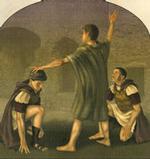A Catholic sci-fi classic: Gene Wolfe’s Book of the New Sun
By Thomas V. Mirus ( bio - articles - email ) | Apr 04, 2016 | In Reviews
Published in four volumes between 1980 and 1982, Gene Wolfe’s Book of the New Sun is considered by many to be the greatest science fiction novel ever written, and by some to be one of the great works of twentieth-century literature. It is also well known to be a significantly Catholic work. Wolfe, a former engineer who invented the machine that makes Pringles, wrote the novel shortly after his conversion.
Free eBook:

|
| Free eBook: Liturgical Year 2024-2025, Vol. 5 |
Set in a distant future in which Urth’s sun is dying and much past knowledge, both religious and technological, has been lost, Book of the New Sun follows the physical, moral and spiritual journey of a young journeyman torturer named Severian who is expelled from the his guild after showing mercy to a client. Plying his trade as an executioner from town to town, he becomes involved with political intrigues that threaten to overthrow the ruler of his country. By seeming chance, he comes into the possession of a relic of an ancient religious figure known as the Conciliator who, it is believed, will one day return to restore the Earth’s sun. This relic heals the sick, raises the dead and exerts a gradual but profound spiritual influence on Severian himself.
The novel is written in the form of Severian’s autobiography, or perhaps even more accurately, his Confessions. One thing which makes this a “difficult” work is that Severian is, in some ways, an unreliable narrator. Countless times throughout the novel he boasts of his perfect memory, yet gives conflicting accounts of certain events. On top of this, many events in the narrative which are mysterious when first recounted only make sense in retrospect. All this makes it virtually impossible to evaluate, much less fully understand, Severian’s tale based on my one reading.
Nonetheless, I agree with those who say that the Book of the New Sun is about the attempts of someone with an utterly disordered upbringing to live virtuously. Severian never knew his parents and was raised in the Guild of the Torturers from childhood, taught to carry out the gruesome sentences of the state without deviation out of either sadism or compassion. Yet he has a heart and a conscience, however mutilated and malformed these may be. His rehabilitation into a human being and his growing awareness of the transcendent, while painfully slow, remind us that what may look like (and truly be) evil behavior to someone possessing the light of faith may in fact reflect moral progress in someone with a greatly disadvantaged starting point.
Cecilia Michel Lopez has argued somewhat convincingly that the Book of the New Sun is not just informed by Catholicism, but is in fact a Christian allegory consciously modeled on works such as the Divine Comedy and other aspects of the medieval literary tradition. This is certainly reflected in the character names, which, when not actually taken from the history of ancient Christianity, often have great etymological significance much in the tradition of onomastics, the patristic and medieval study of names. There is also a good bit of Eucharistic symbolism in forms both distorted and holy. Gene Wolfe himself has said that Severian is a Christian figure (though not a figure of Christ Himself except insofar as every Christian becomes conformed to Him).
The Book of the New Sun, then, is a tale of a torturer who becomes conformed to Christ. This incongruity is apparently the author’s attempt to unravel an incongruity which intrigued him in the Gospel. In Wolfe’s own words:
It has been remarked thousands of times that Christ died under torture. Many of us have read so often that he was “a humble carpenter” that we feel a little surge of nausea on seeing the words yet again. But no one ever seems to notice that the instruments of torture were wood, nails, and a hammer; that the man who built the cross was undoubtedly a carpenter too; that the man who hammered in the nails was as much a carpenter as a soldier, as much a carpenter as a torturer. Very few seem even to have noticed that although Christ was a “humble carpenter,” the only object we are specifically told he made was not a table or a chair, but a whip.
All comments are moderated. To lighten our editing burden, only current donors are allowed to Sound Off. If you are a current donor, log in to see the comment form; otherwise please support our work, and Sound Off!







